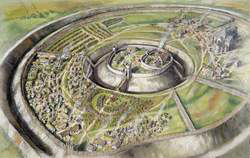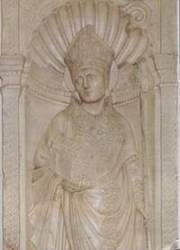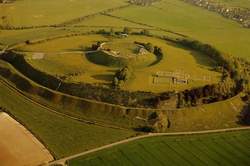The site of Old Sarum has been occupied and abandoned several times over the last
five thousand years. But as this website is only concerned with abandonments that
have taken place since the Middle Ages we will confine the account here to its fortification
and settlement soon after the Norman Conquest and the evacuation that occurred when
the decision was taken to build a new cathedral in Salisbury.
William the Conqueror
chose Sarum as the location for a royal castle, royal in the sense that William and
later kings would sometimes stay here, and also in the sense that important national
events could be held within it. The site was chosen because it lay inside a large
Iron Age hill fort, and initial defences could be constructed very quickly. Just
four years after the conquest, in 1070, having gained control of England, William
used the castle to pay off his troops. They were paid with the proceeds of treasure
left for safety in their minsters by Anglo-
In 1086 the enormous survey of the economy of England that
resulted in the Domesday Book was completed. Much of the writing of the Domesday
Book was done by scribes based at Sarum. On 1 August that year William summoned all
the barons of England to Sarum. William confirmed their ownership of large areas
of land, but in return demanded that they should swear an oath of allegiance to him.
A
wonderful imaginative painting of this event has been made by Peter Dunn. It is reproduced
on this page, but a high resolution copy of it can be obtained from the Photo Library
at English Heritage.
Later kings used Sarum for other purposes. When Henry II discovered that his wife,
Eleanor of Aquitaine, had joined his sons Richard and John in plotting against him,
he ordered her imprisonment. She remained in detention from 1174 until Henry's death
in 1189, being held at Old Sarum as well as at Winchester Castle and Nottingham Castle.
Only at Christmas would Henry sometimes allow Eleanor to stay briefly with him at
Windsor.
A second major development at Sarum was the founding of an important religious
community. The local diocese had in fact been created just before the Norman invasion,
probably in 1059. In 1075 the bishop, Hereman, gained permission for a cathedral
to be built at Sarum, replacing the cathedral at Sherborne. However, Hereman died
in 1078, leaving the task of completing the cathedral to his successor, Osmund.
Bishop
Osmund was a remarkable person in many ways. His origins are uncertain, but he almost
certainly came from a high ranking Norman family, and may have been related to King
William. Before becoming bishop he occupied the position of chancellor to the king.
He showed great respect for established English customs, for example adopting the
Anglo Saxon saint, Aldhelm, as his role model. From his own wealth he provided funding
for the construction of the cathedral and made an endowment of land to generate income
for the cathedral in future. The endowment meant that a large group of about thirty
clergymen could be appointed to serve the diocese. The cathedral became a major centre
for the study and replication of manuscripts, of which a large collection survives
today in the library of Salisbury Cathedral.
For more on the life and significance
of Osmund read Diana Greenway, Saint Osmund: Bishop of Salisbury 1078 to 1099, published
by the Dean and Chapter of Salisbury Cathedral, 1999.
After the death of Osmund it
was generally agreed that he deserved to be declared a saint. At that time the case
for canonisation depended to a large extent on the number and type of miracles performed
by the person on whose behalf the application was made. Evidence of sudden healing
experienced by sick and disabled visitors to Osmund's grave was gathered, and the
first application for Osmund's canonisation was made to the pope during the 1220s.
It was not successful. Further applications were made during the fourteenth and fifteenth
century, and eventually, on 1 January 1457, Osmund was declared a saint by Pope Calixtus
III.


